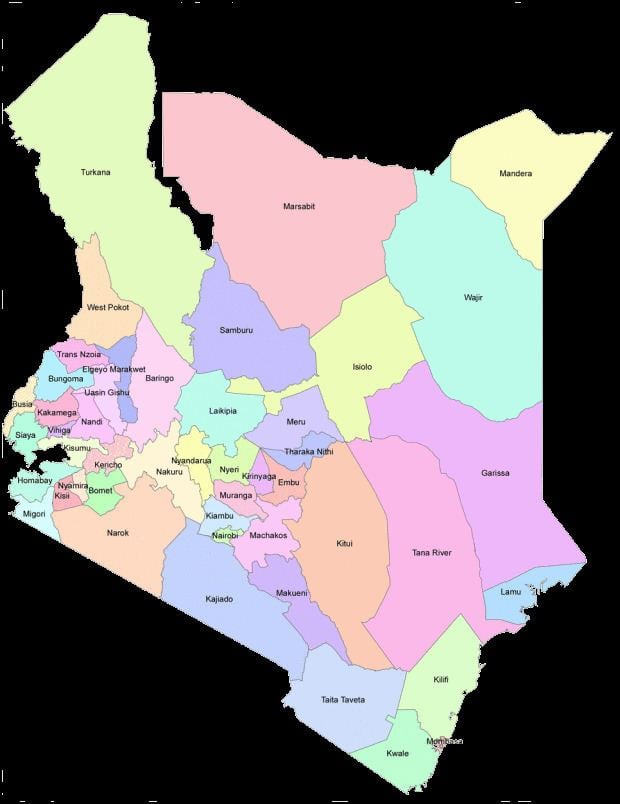Category Semi-Devolved State Number 47 Counties | ||
 | ||
Populations 101,539 (Lamu) – 3,138,369 (Nairobi) Areas 294.7 km (113.8 sq mi) (Mombasa) – 71,597.8 km (27,644.1 sq mi) (Turkana) Government County Government, Government of Kenya | ||
The counties of Kenya are geographical units envisioned by the 2010 Constitution of Kenya as the units of devolved government. The powers are provided in Articles 191 and 192, and in the fourth schedule of the Constitution of Kenya and the County Governments Act of 2012. The counties are also single member constituencies for the election of members of parliament to the Senate of Kenya and special women members of parliament to the National Assembly of Kenya. As of 2013 general elections, there are 47 counties whose size and boundaries are based on the 47 legally recognised Districts of Kenya. Following the re-organisation of Kenya's national administration, counties were integrated into a new national administration with the national government posting county commissioners to represent it at the counties.
Contents
- Establishment
- List of counties
- County Governments
- Agriculture
- County health services
- Pollution Nuisances and Advertising Control
- Cultural activities public entertainment and public amenities
- County transport
- Animal control and welfare
- Trade development and regulation
- County planning and development
- Education and Childcare
- Policy Implementation
- County public works and services
- Coordination
- County Executive Committee
- County Assemblies
- History
- Current List of Governors
- References
Establishment
County governments were established in 47 counties (based on the 1992 Districts of Kenya), after the scheduled general elections in March 2013. The counties' names are set out in the First Schedule of the Constitution of Kenya.
List of counties
Under the new constitution, Kenya is now divided into 47 counties for administrative purposes. They are grouped below according to the former province of which they were part, with their areas and populations as of the 2009 census:
County Governments
County governments are responsible for county legislation (outlined in article 185 of the Constitution of Kenya), executive functions (outlined in article 183), functions outlined in the fourth schedule of the constitution of Kenya, functions transferred from the national government through article 187 of the constitution of Kenya, functions agreed upon with other counties under article 189(2) of the constitution of Kenya, and establishment and staffing of a public service (under article 235 of the Constitution of Kenya). The functions of governments assigned to counties by the fourth schedule of the Constitution of Kenya are:
Agriculture
County health services
Pollution, Nuisances and Advertising Control
Cultural activities, public entertainment and public amenities
County transport
Animal control and welfare
Trade development and regulation
County planning and development
Education and Childcare
Policy Implementation
County public works and services
Coordination
County Executive Committee
The county governor and the deputy county governor are the chief executive and deputy chief executive of the county, respectively. The Independent Electoral and Boundaries Commission shall not conduct a separate election for the deputy governor but shall declare the running mate of the person who is elected county governor to have been elected as the deputy governor. Each county will be run by an executive committee, consisting of:
As a specialty in the democratic system Kenyan law requires governors to have a recognized university degree (it is not necessary for the President of the United States, for example, to hold a degree).
County Assemblies
The counties will each have an assembly whose members are elected from single member constituencies known as wards. There may also be a number of nominated members as is necessary to ensure that neither male nor female members constitute more than two-thirds of the assembly. There will also be six nominated members to represent marginalized groups (persons with disabilities, and the youth) and a speaker who will be an ex officio member of the assembly.
History
Embu County governor Martin Nyagah Wambora was the first governor to be impeached following allegations of impropriety.
Current List of Governors
The governors listed below took office on 27 March 2013, unless otherwise noted.
